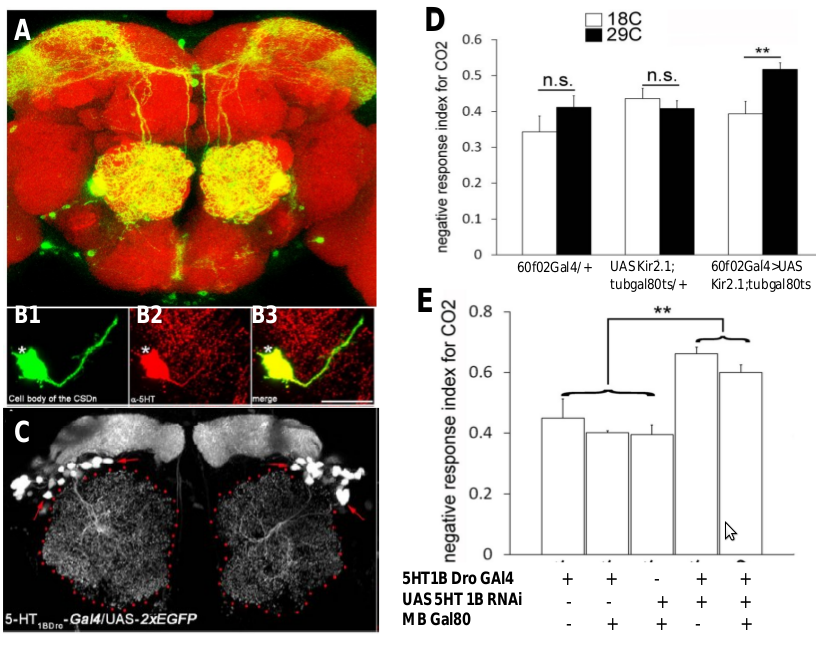Dr. Veronica Rodrigues - Drosophila olfactory neurons
| People | Activity-dependent mechanisms during development of Drosophila olfactory neurons |
|
Ajeet Pratap Singh & Rudra Nayan Das |
Developmental mechanisms and modulatory functions of a central serotonergic neuron in the Drosophila antennal lobe
Neuromodulators are essential for proper development and functioning of metazoan nervous system. Serotonin, an ancient neuromodulator is involved in regulating variety of behaviors .Its misregulation is implicated in neuropsychiatric disorders like depression, schizophrenia and anxiety. In flies, genetic and pharmacological studies provide evidences for involvement of serotonin in innate behaviours like sleep, circadian rhythm, courtship, aggression and learning. Driven by the keen desire to understand the basic mechanism by which serotonin regulates these aspects we focused our study on an identified pair of serotonergic interneuron (The CSDn- contralaterally-projecting, serotonin-immunoreactive deutocereberal neuron) innervating the antennal lobe of Drosophila melanogaster. Its unique morphology coupled with genetic amenability makes CSDn an ideal system to study both developmental and functional importance of serotonin at the level of a single neuron. Blocking neurotransmitter release from CSDn resulted in abnormal odour sensitivity, indicating its active role in modulation of odour sensing. Using mosaic method to label single neuron from the pair, we observed glomerular-specific distribution of the CSDn axonal terminals. We further found that CSDn-derived Ephrin interacts with sensory neuron-derived Eph in positioning its terminals in a glomerular-specific manner.By correlating variation in arborization to behavior, we demonstrated that changing the pattern of target-field branching in specific glomeruli is associated with change in olfactory sensitivity for the cognate odour. These results decipher glomerular-specific neurite-patterning strategies of modulatory neurons, responding to sensory neuron-derived cues, and lay a framework for understanding the developmental strategies which regulate the wiring of modulatory components of the olfactory circuit |
|
Gururaj |
Figure 1- (A)The CSDn (contralaterally-projecting, serotonin-immunoreactive deutocereberal neuron) being marked by bilateral flip-out of flies with genotype RN2flp, tub>CD2>Gal4, UASmCD8::GFP. (B1-3) Soma of CSD neuron (green) is strongly labeled with anti-Serotonin (red) (soma is indicated with white asterisk). Serotonin staining can also be seen in the main axon trunk. (D) Adult-specific suppression of CSDn excitability using R60FO2Gal4 results in increased CO2 avoidance (n=17; p=0.006). (C)5-HT1BDro-Gal4 marks a subset of local interneurons in the adult antennal lobe. Adult brain of 5-HT1BDro-Gal4::UAS 2xEGFP showing GFP expression in few local interneurons around the antennal lobe whose cell bodies are located in the lateral cluster (red arrows). Dotted circles outline antennal lobes . (E) RNAi-mediated knock down of 5-HT1BDro in the 5-HT1BDro expression domain (5-HT1BDro-Gal4/+; UAS-5-HT1BDroRNAi/+, n=11) results in increased CO2 sensitivity (p<0.05 , n>7). 5-HT1BDro expression in the mushroom bodies may not be necessary for CO2 sensitivity as blocking 5-HT1BDroRNAi expression in mushroom body neurons (MB-Gal80/+; 5-HT1BDro-Gal4/+; UAS-5-HT1BDroRNAi/+, n=14) does not ameliorate increased CO2 sensitivity (p=0.12 compared to 5-HT1BDro-Gal4/+; UAS-5-HT1BDroRNAi/+, n=11) and animals exhibit increased CO2 avoidance (p<0.01 compared to all control genotypes, n>7). Significance was assessed by Mann-Whitney test. *, p<0.05; **, p<0.01; ***, p<0.0001; n.s. (not significant), p>0.05. |
|
Collaborators: 1. Mathias Landgraf , Department of Zoology, University of Cambridge, Downing Street, Cambridge, CB2 3EJ, UK 2. Janelia Farms (We acknowledge Jim Truman and Gerry Rubin for the CSD-gal4 line and Vivek for imaging) Publications Singh, A. P., VijayRaghavan, K. and Rodrigues, V. (2010). Dendritic refinement of an identified neuron in the Drosophila CNS is regulated by neuronal activity and Wnt signaling. Development 137, 1351-1360. Singh, A. P., Rodrigues, V. and VijayRaghavan, K. (2010). Actin Reorganization in Nerve Morphogenesis. In: Encyclopedia of Life Sciences (ELS). John Wiley & Sons, Ltd: Chichester. DOI: 10.1002/9780470015902.a0021850 Roy, B., Singh, A. P., Shetty, C., Chaudhary, V., North, A., Landgraf, M., VijayRaghavan, K. and Rodrigues, V. (2007). Metamorphosis of an identified serotonergic neuron in the Drosophila olfactory system. Neural Development 2, 20. |
|






